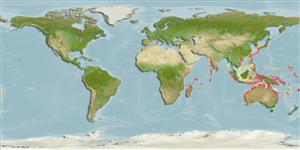>
Gobiiformes (Gobies) >
Gobiidae (Gobies) > Gobiinae
Etymology: Trimmatom: Greek, trimma, -atos = something crushed + Greek, tomos = cut (Ref. 45335).
More on author: Winterbottom.
Environment: milieu / climate zone / depth range / distribution range
Ekologi
laut berasosiasi dengan karang; kisaran kedalaman 0 - 28 m (Ref. 90102). Tropical
Indo-West Pacific: Seychelles, Cargados Carajos, Chagos Archipelago to Sumatra and the Philippines, north to Japan, south to Papua New Guinea, the Solomon Islands, and the Timor Sea.
Size / Weight / umur
Maturity: Lm ? range ? - ? cm
Max length : 2.2 cm TL jantan/; (Ref. 90102)
deskripsi pendek
Morfologi | Morfometrik
Duri punggung (Keseluruhan (total)): 6; duri punggung lunak (Keseluruhan (total)): 9; Sirip dubur lunak: 9. Trimmatom pharus differs from T. nanus, T. offucius, and T. sagma in possessing scales on the body (vs naked) and branched pelvic fin rays (vs unbranched). Trimmatom zapotes, T. macropodus, and T. pharus all have body scales but T. zapotes has unbranched pelvic fin rays, and T. macropodus has the first four pelvic fin rays branched. Trimmatom pharus shares many meristic characteristics with T. eviotops including the presence of body scales and the branching of the first four pelvic fin rays; the two species do, however, differ in details of colour pattern. In preserved specimens the first body bar on T. eviotops crosses the pectoral base and the extends over the dorsum, passing backwards to the dorsal fin. In Trimmatom pharus the body bar which crosses the pectoral base crosses the dorsal surface anterior to the dorsal fin. Trimmatom eviotops has a broad dark saddle on the dorsall half of the caudal peduncle, while Trimmatom pharus has a narrow body bar or small dark saddle (Ref. 52310).
Inhabits shoals, reefs and lagoons in 0-28 m (Ref. 90102).
Life cycle and mating behavior
Kematangan | Reproduksi, perkembang biakan | Pemijahan | telur-telur | Fecundity | Larva
Winterbottom, R., 2001. Two new gobiid fish species in Trimma and Trimmatom (Teleostei: Gobiidae) from the Indian and Western Pacific Oceans. aqua, J. Ichthyol. Aquat. Biol. 5(1):19-24. (Ref. 52310)
Status IUCN Red List (Ref. 130435)
ancaman kepada manusia
Harmless
penggunaan manusia
informasi lanjut
Nama-nama umumSinonim (persamaan)metabolismePemangsaEkotoksikologiReproduksi, perkembang biakanKematanganPemijahanSpawning aggregationFecunditytelur-telurpekembangan telor
Umur / SaizPertumbuhanpanjang-beratpanjang-panjangukuran frekuensiMorfometrikMorfologiLarvaDinamika larvapemulihanKelimpahanBRUVS
AcuanBudidaya airprofil budidaya airStrainGenetikaElectrophoresesDiturunkanPenyakit-penyakitPengolahanNutrientsMass conversion
mitraGambarStamps, Coins Misc.Suara-suaraCiguateraKecepatanTipe renangArea insangOtolithsOtakPenglihatan / visi
Alat, peralatan
laporan khas
muat turun XML
Sumber internet
Estimates based on models
Preferred temperature (Ref.
123201): 23.5 - 29.3, mean 28.2 °C (based on 2040 cells).
Phylogenetic diversity index (Ref.
82804): PD
50 = 0.5078 [Uniqueness, from 0.5 = low to 2.0 = high].
Bayesian length-weight: a=0.00708 (0.00333 - 0.01504), b=3.09 (2.92 - 3.26), in cm total length, based on LWR estimates for this (Sub)family-body shape (Ref.
93245).
Trophic level (Ref.
69278): 3.0 ±0.3 se; based on size and trophs of closest relatives
Daya lenting (Ref.
120179): Tinggi, Waktu penggandaan populasi minimum kurang dari 15 bulan (Preliminary K or Fecundity.).
Fishing Vulnerability (Ref.
59153): Low vulnerability (10 of 100).
